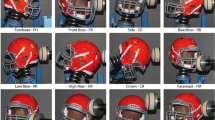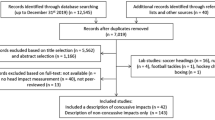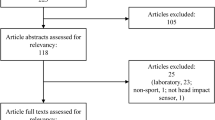Abstract
Measuring head impacts in sports can further our understanding of brain injury biomechanics and, hopefully, advance concussion diagnostics and prevention. Although there are many head impact sensors available, skepticism on their utility exists over concerns related to measurement error. Previous studies report mixed reliability in head impact sensor measurements, but there is no uniform approach to assessing accuracy, making comparisons between sensors and studies difficult. The objective of this paper is to introduce a two-phased approach to evaluating head impact sensor accuracy. The first phase consists of in-lab impact testing on a dummy headform at varying impact severities under loading conditions representative of each sensor’s intended use. We quantify in-lab accuracy by calculating the concordance correlation coefficient (CCC) between a sensor’s kinematic measurements and headform reference measurements. For sensors that performed reasonably well in the lab (CCC ≥ 0.80), we completed a second phase of evaluation on-field. Through video validation of impacts measured by sensors on athletes, we classified each sensor measurement as either true-positive and false-positive impact events and computed positive predictive value (PPV) to summarize real-world accuracy. Eight sensors were tested in phase one, but only four sensors were assessed in phase two. Sensor accuracy varied greatly. CCC from phase one ranged from 0.13 to 0.97, with an average value of 0.72. Overall, the four devices that were implemented on-field had PPV that ranged from 16.3 to 91.2%, with an average value of 60.8%. Performance in-lab was not always indicative of the device’s performance on-field. The methods proposed in this paper aim to establish a comprehensive approach to the evaluation of sensors so that users can better interpret data collected from athletes.





Similar content being viewed by others
References
Bartsch, A., S. Samorezov, E. Benzel, C. Clinic, V. Miele and D. Brett. Validation of an “intelligent mouthguard” single event head impact dosimeter. 2014.
Beckwith, J. G., R. M. Greenwald, and J. J. Chu. Measuring head kinematics in football: Correlation between the head impact telemetry system and hybrid iii headform. Ann. Biomed. Eng. 40(1):237–248, 2012.
Camarillo, D. B., P. B. Shull, J. Mattson, R. Shultz, and D. Garza. An instrumented mouthguard for measuring linear and angular head impact kinematics in American football. Ann. Biomed. Eng. 41(9):1939–1949, 2013.
Campolettano, E. T., R. A. Gellner, and S. Rowson. High-magnitude head impact exposure in youth football. J. Neurosurg. Pediatr. 20(6):604–612, 2017.
Cecchi, N. J., D. C. Monroe, J. J. Phreaner, S. L. Small, and J. W. Hicks. Patterns of head impact exposure in men’s and women’s collegiate club water polo. J. Sci. Med. Sport. 23(10):927–931, 2020.
Cobb, B. R., A. M. Zadnik and S. Rowson. Comparative analysis of helmeted impact response of hybrid iii and national operating committee on standards for athletic equipment headforms. Proc. Inst. Mech. Eng. Part P 230(1):50-60, 2016.
Cobb, B. R., A. MacAlister, T. J. Young, A. R. Kemper, S. Rowson and S. M. Duma. Quantitative comparison of hybrid iii and national operating committee on standards for athletic equipment headform shape characteristics and implications on football helmet fit. Proc. Inst. Mech. Eng. Part. 229(1):39-46, 2015.
Cortes, N., A. E. Lincoln, G. D. Myer, L. Hepburn, M. Higgins, M. Putukian, and S. V. Caswell. Video analysis verification of head impact events measured by wearable sensors. Am. J. Sports Med. 45(10):2379–2387, 2017.
Crisco, J. J., and R. M. Greenwald. Let’s get the head further out of the game: A proposal for reducing brain injuries in helmeted contact sports. Curr Sports Med Rep. 10(1):7–9, 2011.
Cummiskey, B., D. Schiffmiller, T. M. Talavage, L. Leverenz, J. J. Meyer, D. Adams and E. A. Nauman. Reliability and accuracy of helmet-mounted and head-mounted devices used to measure head accelerations. Proc. Inst. Mech. Eng. Part P 231(2):144-53, 2016.
Daniel, R. W., S. Rowson, and S. M. Duma. Head impact exposure in youth football. Ann. Biomed. Eng. 40(4):976–981, 2012.
Duma, S. M., S. J. Manoogian, W. R. Bussone, P. G. Brolinson, M. W. Goforth, J. J. Donnenwerth, R. M. Greenwald, J. J. Chu, and J. J. Crisco. Analysis of real-time head accelerations in collegiate football players. Clin. J. Sport Med. 15(1):3–8, 2005.
Eckner, J. T., K. L. O’Connor, S. P. Broglio, and J. A. Ashton-Miller. Comparison of head impact exposure between male and female high school ice hockey athletes. Am. J. Sports Med. 46(9):2253–2262, 2018.
Funk, J. R., S. Rowson, R. W. Daniel, and S. M. Duma. Validation of concussion risk curves for collegiate football players derived from hits data. Ann Biomed Eng. 40(1):79–89, 2012.
Greenwald, R. M., J. J. Chu, J. J. Crisco and J. A. Finkelstein. Head impact telemetry system (hits) for measurement of head acceleration in the field. Proceedings of the American Society of Biomechanics Annual Meeting. 2003.
Hecimovich, M., D. King, A. Dempsey, and M. Murphy. Head impact exposure in junior and adult australian football players. J. Sports Med. 2018. https://doi.org/10.1155/2018/8376030.
Jadischke, R., D. C. Viano, N. Dau, A. I. King, and J. McCarthy. On the accuracy of the head impact telemetry (hit) system used in football helmets. J. Biomech. 46(13):2310–2315, 2013.
Kieffer, E. E., C. Vaillancourt, P. G. Brolinson and S. Rowson. Using in-mouth sensors to measure head kinematics in rugby. IRCOBI. 2020.
Kuo, C., L. C. Wu, B. T. Hammoor, J. F. Luck, H. C. Cutcliffe, R. C. Lynall, J. R. Kait, K. R. Campbell, J. P. Mihalik, C. R. Bass, and D. B. Camarillo. Effect of the mandible on mouthguard measurements of head kinematics. J. Biomech. 49(9):1845–1853, 2016.
Lamond, L. C., J. B. Caccese, T. A. Buckley, J. Glutting, and T. W. Kaminski. Linear acceleration in direct head contact across impact type, player position, and playing scenario in collegiate women’s soccer players. J. Athl. Train. 53(2):115–121, 2018.
Lawrence, I. and K. Lin. A concordance correlation coefficient to evaluate reproducibility. Biometrics. 255-68, 1989.
Miller, L. E., E. K. Pinkerton, K. C. Fabian, L. C. Wu, M. A. Espeland, L. C. Lamond, C. M. Miles, D. B. Camarillo, J. D. Stitzel, and J. E. Urban. Characterizing head impact exposure in youth female soccer with a custom-instrumented mouthpiece. Res. Sports Med. 28(1):55–571, 2020.
Nevins, D., K. Hildenbrand, J. Kensrud, A. Vasavada and L. Smith. Laboratory and field evaluation of a small form factor head impact sensor in un-helmeted play. Proc. Inst. Mech. Eng. Part P 232(3):242–254, 2018.
Nevins, D., L. Smith, and J. Kensrud. Laboratory evaluation of wireless head impact sensor. Procedia Eng. 112(2015):175–179, 2015.
Ng, T. P., W. R. Bussone, and S. M. Duma. The effect of gender and body size on linear accelerations of the head observed during daily activities. Biomed. Sci. Instrum. 42:25–30, 2006.
O’Connor, K. L., S. Rowson, S. M. Duma, and S. P. Broglio. Head-impact–measurement devices: a systematic review. J. Athl. Train. 52(3):206–227, 2017.
Patton, D. A. A review of instrumented equipment to investigate head impacts in sport. Appl. Bionics Biomech. https://doi.org/10.1155/2016/7049743
Patton, D. A., C. M. Huber, C. C. McDonald, S. S. Margulies, C. L. Master, and K. B. Arbogast. Video confirmation of head impact sensor data from high school soccer players. Am. J. Sports Med. 48(5):1246–1253, 2020.
Press, J. N., and S. Rowson. Quantifying head impact exposure in collegiate women’s soccer. Clin. J. Sport Med. 27(2):104–110, 2017.
Rich, A. M., T. M. Filben, L. E. Miller, B. T. Tomblin, A. R. Van Gorkom, M. A. Hurst, R. T. Barnard, D. S. Kohn, J. E. Urban, and J. D. Stitzel. Development, validation and pilot field deployment of a custom mouthpiece for head impact measurement. Ann. Biomed. Eng. 47(10):2109–21021, 2019.
Rowson, S., E. T. Campolettano, S. M. Duma, B. Stemper, A. Shah, J. Harezlak, L. Riggen, J. P. Mihalik, K. M. Guskiewicz, C. Giza, A. Brooks, K. Cameron, T. McAllister, S. P. Broglio, and M. McCrea. Accounting for variance in concussion tolerance between individuals: Comparing head accelerations between concussed and physically matched control subjects. Ann. Biomed. Eng. 47(10):2048–2056, 2019.
Rowson, S., and S. M. Duma. Development of the star evaluation system for football helmets: Integrating player head impact exposure and risk of concussion. Ann Biomed Eng. 39(8):2130–2140, 2011.
Rowson, S., M. W. Goforth, D. Dietter, P. G. Brolinson, and S. M. Duma. Correlating cumulative sub-concussive head impacts in football with player performance—biomed. Biomed Sci Instrum. 45:113–118, 2009.
Savino, A. K., L. Huang, J. Yang, N. M. Pizzimenti, M. T. McCarthy, and S. C. Rose. Head impact burden differs between seasons in youth and high school us football players. Ann. Biomed. Eng. 2020. https://doi.org/10.1007/s10439-020-02548-3.
Siegmund, G. P., K. M. Guskiewicz, S. W. Marshall, A. L. DeMarco, and S. J. Bonin. Laboratory validation of two wearable sensor systems for measuring head impact severity in football players. Ann. Biomed. Eng. 44(4):1257–1274, 2016.
Stemper, B. D., A. S. Shah, J. Harezlak, S. Rowson, J. P. Mihalik, S. M. Duma, L. D. Riggen, A. Brooks, K. L. Cameron, D. Campbell, J. P. DiFiori, C. C. Giza, K. M. Guskiewicz, J. Jackson, G. T. McGinty, S. J. Svoboda, T. W. McAllister, S. P. Broglio, M. McCrea and C. C. I. the. Comparison of head impact exposure between concussed football athletes and matched controls: Evidence for a possible second mechanism of sport-related concussion. Ann. Biomed. Eng. 47(10):2057-2072, 2019.
Tiernan, S., G. Byrne, and D. O’Sullivan. Evaluation of skin-mounted sensor for head impact measurement. Proc. Inst. Mech. Eng. Part H. 233:095441191985096, 2019.
Tierney, G. J., C. Kuo, L. Wu, D. Weaving, and D. Camarillo. Analysis of head acceleration events in collegiate-level american football: A combination of qualitative video analysis and in-vivo head kinematic measurement. J. Biomech. 110:109969, 2020.
Tyson, A. M., S. M. Duma, and S. Rowson. Laboratory evaluation of low-cost wearable sensors for measuring head impacts in sports. 34(4):320, 2018.
Urban, J. E., E. M. Davenport, A. J. Golman, J. A. Maldjian, C. T. Whitlow, A. K. Powers and J. D. Stitzel. Head impact exposure in youth football: High school ages 14 to 18 years and cumulative impact analysis. Ann Biomed Eng. 2013.
Viano, D. C., and D. Halstead. Change in size and impact performance of football helmets from the 1970s to 2010. Ann Biomed Eng. 40(1):175–184, 2012.
Withnall, C., N. Shewchenko, R. Gittens, and J. Dvorak. Biomechanical investigation of head impacts in football. Br. J. Sports Med. 39(suppl 1):i49–i57, 2005.
Wu, L. C., V. Nangia, K. Bui, B. Hammoor, M. Kurt, F. Hernandez, C. Kuo, and D. B. Camarillo. In vivo evaluation of wearable head impact sensors. Ann. Biomed. Eng. 44(4):1234–1245, 2016.
Zhou, Y. J., G. Lu, and J. L. Yang. Finite element study of energy absorption foams for headgear in football (soccer) games. Mater. Des. 88:162–169, 2015.
Acknowledgments
The authors thank the Lewis Family Foundation for funding this work. The authors have no conflicts of interest to disclose.
Author information
Authors and Affiliations
Corresponding author
Additional information
Associate Editor Stefan M. Duma oversaw the review of this article.
Publisher's Note
Springer Nature remains neutral with regard to jurisdictional claims in published maps and institutional affiliations.
Rights and permissions
About this article
Cite this article
Kieffer, E.E., Begonia, M.T., Tyson, A.M. et al. A Two-Phased Approach to Quantifying Head Impact Sensor Accuracy: In-Laboratory and On-Field Assessments. Ann Biomed Eng 48, 2613–2625 (2020). https://doi.org/10.1007/s10439-020-02647-1
Received:
Accepted:
Published:
Issue Date:
DOI: https://doi.org/10.1007/s10439-020-02647-1




